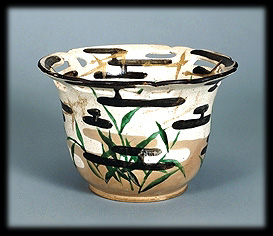

![]()

Kenzan Bowl
Ogata Kenzan (1663-1743)
Bowl with Reticulated Rim
Kyoto Prefecture
Edo period, early 18th century
Stoneware with pierced design and painted with slips under glaze and overglaze enamels and gold (Kyoto ware)
Kenzan was raised in a prosperous family of textile makers for the Kyoto aristocracy, and was intimate with the Rinpa tradition through his brother Korin, a painter. The pierced openwork and commitment to surface treatment identify this bowl as a Kenzan innovation during his tenure at Kyoto's Chojiyamachi kiln (1712-31). Like Ninsei, Kenzan signed his ceramics, and was also renowned as a painter. The wild geese depicted through abstract gold symbols are echoed in the gold decoration of the Koetsu calligraphy scroll in this section.
Kyoto Ceramics
For 800 years, Kyoto was the imperial capital of Japan. Craft industries of the highest order flourished there, and hopes of royal patronage attracted the finest artists. Even after the political capital shifted to Edo (Tokyo) in 1600, Kyoto remained the cultural capital, and lacquer, textiles, ceramics produced there carried the greatest prestige. A Kyoto trademark guaranteed both recognition and sales. Unlike the commercial Arita kilns--which produced porcelains for high and low, domestic and export markets--Kyoto potters made stonewares in tea ceremony style for domestic consumers.
Many Kyoto potters were renowned artists who signed their works. This section displays works of two of the most celebrated, Nonomura Ninsei and his student Ogata Kenzan.